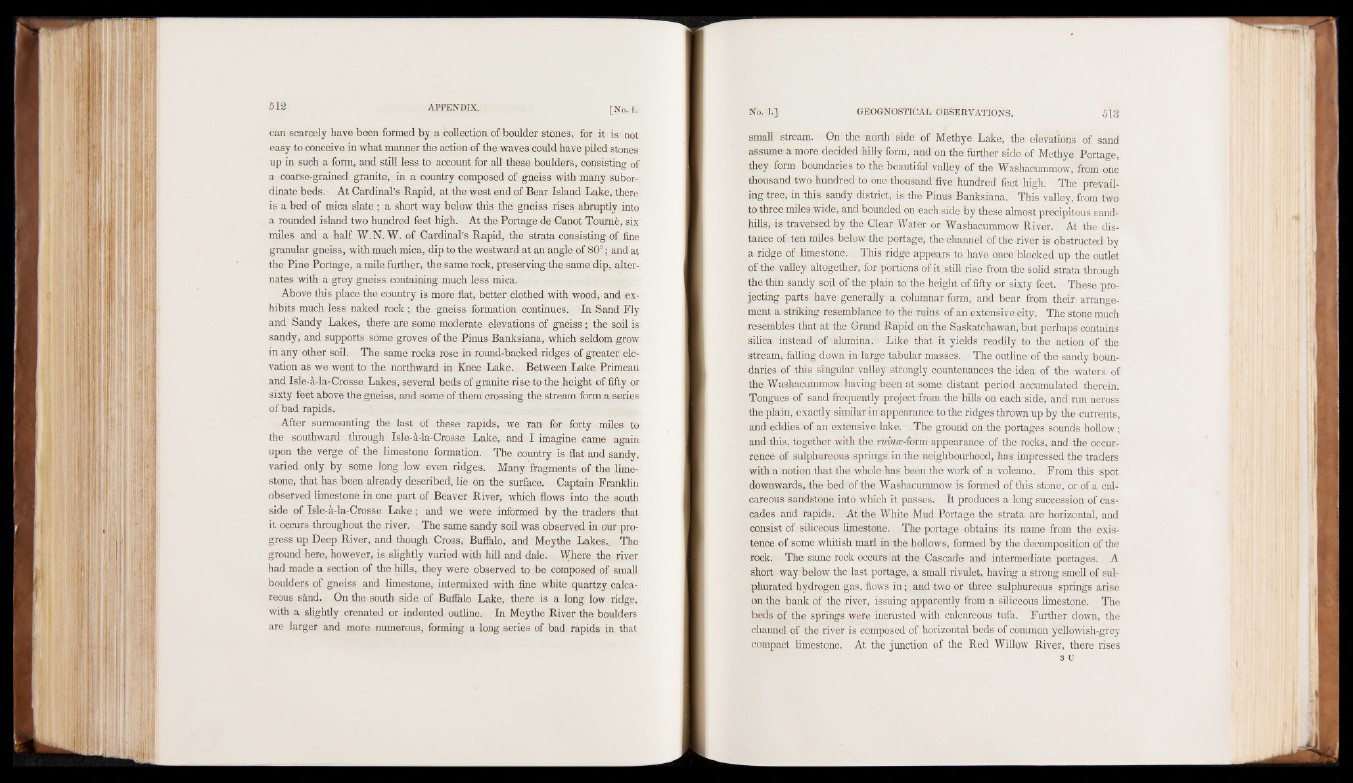
can scarcely have been formed by a collection of boulder stones, for it is not
easy to conceive in what manner the action of the waves could have piled stones
up in such a form, and still less to account for all these boulders, consisting of
a coarse-grained granite, in a country composed of gneiss with many subordinate
beds. At Cardinal’s Rapid, at the west end of Bear Island Lake, there'
is a bed of mica slate ; a short way below this the gneiss rises abruptly into
a rounded island two hundred feet high. At the Portage de Canot Tournè, six
miles and a half W.N. W. of Cardinal’s Rapid, the strata consisting of fine
granular gneiss, with much mica, dip to the westward at an angle of 80°; and at
the Pine Portage, a mile further, the same rock, preserving the same dip, alternates
with a grey gneiss containing much less mica.
Above this place the country is more flat, better clothed with wood, and exhibits
much less naked rock; the gneiss formation continues. In Sand Fly
and Sandy Lakes, there are some moderate elevations of gneiss; the soil is
sandy, and supports some groves of the Pinus Banksiana, which seldom grow
in any other soil. The same rocks rose in round-backed ridges of greater elevation
as we went to the northward in Knee Lake. Between Lake Primeau
and Isle-a-Ia-Crosse Lakes, several beds of granite rise to the height of fifty or
sixty feet above the gneiss, and some of them crossing the stream form a series
of bad rapids.
After surmounting the last of these rapids, we ran for forty miles to
the southward through Isle-i-la-Crosse Lake, and I imagine came again
upon the verge of the limestone formation. The country is flat and sandy,
varied only by some long low éven ridges. Many fragments of the limestone,
that has been already described, lie on the surface. Captain Franklin
observed limestone in one part of Beaver River, which flows into the south
side of Isle-a-la-Crosse Lake; and we were informed by the traders that
it occurs throughout the river. The same sandy soil was observed in our progress
up Deep River, and though Cross, Buffalo, and Meythe Lakes.. The
ground here, however, is slightly varied with hill and dale. Where the river
had made a section of the hills, they were observed to be composed of small
boulders of gneiss and limestone, intermixed with fine white quartzy calcareous
shnd. On the south side of Buffalo Lake, there is a long low ridge,
with a slightly crenated or indented outline. In Meythe River the boulders
are larger and more numerous, forming a long series of bad rapids in that
small stream. On the north side of Methye Lake, the elevations of sand
assume a more, decided hilly form, and on the further side of Methye Portage,
they form boundaries to the beautiful valley of the Washacummow, from one
thousand two hundred to one thousand five hundred feet high. The prevailing
tree, in this sandy district, is the Pinus Banksiana. This valley, from two
to threemiles wide, and bounded on each side by these almost precipitous sandhills,
is traversed by the Clear Water or Washacummow River. At the distance
of ten miles below the portage, the channel of the-river is obstructed by
a .ridge of limestone. This ridge appears to have once blocked up the outlet
of the valley altogether, for portions of it, still rise from the solid strata through
the thin sandy soil of the plain to the height of fifty or sixty feet. These projecting
parts have generally a columnar form, and bear from their arrangement
a striking resemblance to the ruins of an extensive city. The stone much
resembles that at the Grand Rapid on the Saskatchawan, but perhaps contains
silica instead of alumina. Like that it yields readily to the action of the
stream, falling down in large tabular masses. The outline of the sandy boundaries
of this singular valley strongly countenances the idea of the waters of
the Washacummow having been at some distant period accumulated therein.
Tongues of sand frequently project from the hills on each side, and run across
the plain, exactly similar in appearance to the ridges thrown up by the currents,
and eddies of an extensive lake. The ground on the portages sounds hollow;
and this, together with the m«®-form appearance of the rocks, and the occurrence
of sulphureous springs in the neighbourhood, has impressed the traders
with a notion that the whole has been the work of a volcano. From this spot
downwards, the bed of the Washacummow is formed of this stone, or of a calcareous
sandstone into which it passes. It produces a long succession of cascades
and rapids. At the White Mud Portage the strata are horizontal, and
consist of . siliceous limestone. The portage obtains its name from the existence
of some whitish marl in the hollows, formed by the decomposition of the
rock. The same rock occurs at the Cascade and intermediate portages. A
short way below the last portage, a small rivulet, having a strong smell of sulphurated
hydrogen gas, flows in; and two or three sulphureous springs arise
on the bank of the river, issuing apparently from a siliceous limestone. The
beds of the springs were incrusted with calcareous tufa. Further down, the
channel of the river is composed of horizontal beds of common yellowish-grey
compact limestone. At the junction of the Red Willow River, there rises